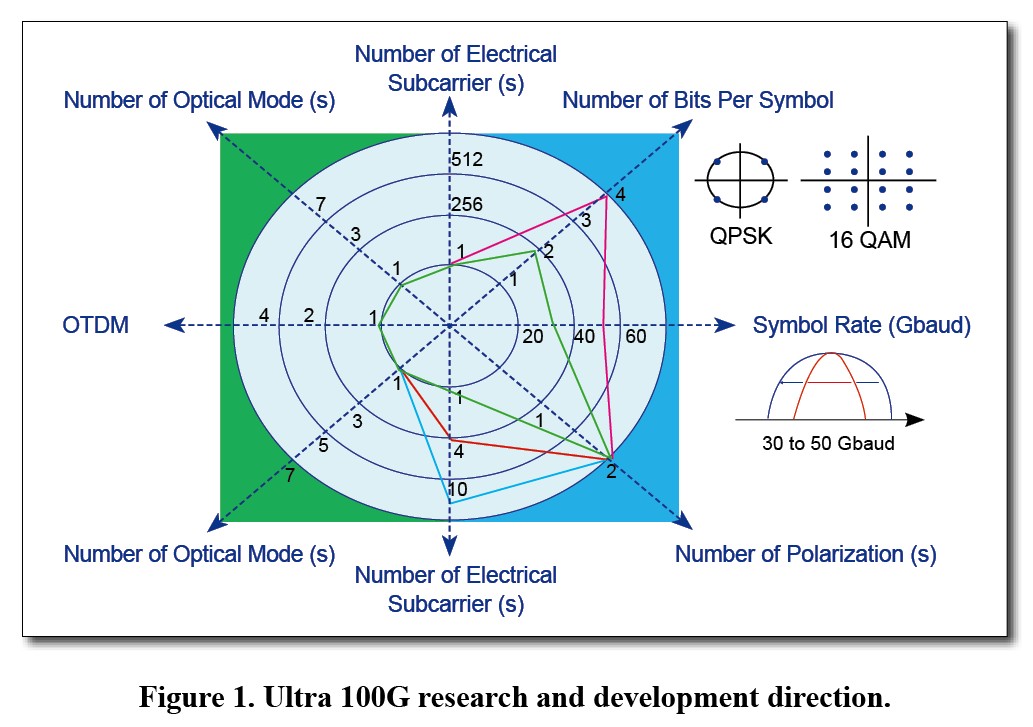Ultra 100GTechnologies
With the emergence of HDTV, 3DTV, cloud computing, Internet of things and other high-bandwidth applications, demand for network transmission bandwidth has increased. To meet the 30 to 50 percent annual increase in bandwidth demand, Verizon, Deutsche Telekom, BT, Telefonica, and other large operators are looking past 100G to ultra 100G solutions.
ZTE estimates that 400G systems will be commercialized by 2015 and 1T services will be commercialized after 2018. ZTE has been committed to researching 400G and 1T technologies for years. At the Optical Fiber Conference 2011, ZTE announced it had transmitted a signal with a single-channel transmission rate of 11.2 Tbit/s. The signal was transmitted over 640 km standard single-mode fiber. At the Optoelectronics and Communications Conference (OECC) 2011, ZTE unveiled the world's first 1 Tbit/s DWDM prototype system and provided test results.
These achievements demonstrate ZTE's technical strength and give a clear direction to the development of optical communications. ZTE believes that ultra 100G technologies will develop on the basis of existing 100G technologies. 100G coherent detection reception, soft-decision forward error correction (SD-FEC), polarization multiplexing, and phase coding format can all be applied to ultra 100G systems.
Research on ultra 100G technologies is underway to seek a balance between capacity, transmission rate, and optical transmission distance.

There are three main methods of increasing the channel bit rate in an ultra 100G system.
The first method involves increasing the signal baud rate. However, transmission distance is greatly reduced when the baud rate of polarization-multiplexed quadrature phase-shift keying (QPSK) or 16-QAM (used in current 100G commercial systems or 400G dual-carrier prototypes) is multiplied.
The second method involves using higher-order QAM codes. This produces higher spectral efficiency than PDM-QPSK but leads to higher implementation cost and higher requirements on reception sensitivity. Transmission distance is also reduced. 16-QAM signals require an optical signal-to-noise ratio (OSNR) that is 6 dB higher than QPSK. This ratio increases exponentially with the increase of constellation points. On existing networks, a 512 Gbit/s dual-carrier 16-QAM signal can be transmitted about 700 km. This implies there are many challenges in using 16-QAM or 64-QAM to improve spectral efficiency.
The third method involves using multisubcarrier multiplexing super channels. High-integration 100G/200G channels overcome the speed and bandwidth limitation of optoelectronic devices. Coherent optical orthogonal frequency division multiplexing (CO-OFDM) and Nyquist WDM are the best-known multicarrier techniques.
At present, the 100G technology based on single-carrier PDM-DQPSK modulation is capable of spectral efficiency of 2 bit/s/Hz with traditional 50 GHz spacing. Multisubcarrier multiplexing is capable of a spectral efficiency of about 4 bit/s/Hz, and the transmission distance is not significantly reduced.
In February 2012, ZTE joined with DT to trial 400G/1T prototypes based on multisubcarrier multiplexing technology. Nyquist-WDM was used to generate a 400 Gbit/s superchannel using four 112 Gbit/s PDM-QPSK signals that were multiplexed after filtering. A 1 Tbit/s channel with 13 subchannels was created using CO-OFDM. Each subchannel occupied 25 GHz, and the total signal bandwidth was 325 GHz. With these two superchannels and ZTE’s two commercial 100G line cards, hybrid transmission was possible. After the signals were transmitted over 1750 km, the bit error ratios (BERs) of all signals were less than 2 × 10-3.
The trial proved that Nyquist-WDM is an optimal solution for ultralong-haul transmission. In addition, ZTE’s 400G and 1T technologies are compatible with original commercial 100G technologies.
Multisubcarrier multiplexing can also work alongside the other two methods. In the Deutsche Telekom laboratory, ZTE tested an 8 × 216.8 Gbit/s PDM-CSRZ-QPSK system on the existing network. ZTE used Nyquist-WDM and increased the baud rate to 54.2 Gbaud. The signals had spectral efficiency of 4 bit/s/Hz. After they were transmitted over 1750 km, the BER of all signals was lower than the forward error correction threshold. This proved that baud rate and channel capacity can be doubled, and ultralong-haul transmission can be achieved using QPSK with 50 GHz spacing.
Sub-subcarrier multiplexing and 16-QAM modulation can be combined to further boost spectral efficiency, but there is a lot of work to be done before they can be used for long-haul transmission.
Channel bit rate can be enhanced after in-depth study of these technologies, but it is difficult to continuously improve spectral efficiency because of the limit defined by Shannon’s law. Customers care more about the maximum product when transmission distance multiplies spectral efficiency. Therefore, ZTE plans to launch optical modules that can use the digital signal processing technology of the transmitting end to dynamically change the modulation format and baud rate. These modules can also support self-adaptation of line rates. The optical modules can be used in conjunction with a flexible electrical-layer encapsulation and adaptation technique, and dynamic spectrum resource allocation to create a flexible self-adaptive optical transmission network. This will ensure fiber resources are optimally used.
ZTE will concentrate on high-speed transmission technologies and will research all kinds of ultra 100G devices and network technologies. ZTE helps network carriers address the exponential increase in backbone network traffic that has arisen as a result of the boom in data services.